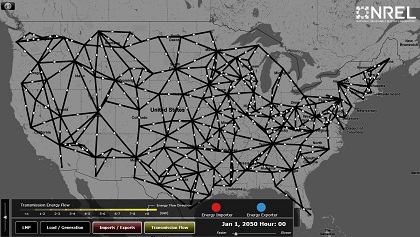
The power flow map and others are available from the NREL report website.
A report published by the National Renewable Energy Laboratory (NREL), the Renewable Electricity Futures Study (RE Futures), is an initial investigation of the extent to which renewable energy supply can meet the electricity demands of the continental United States over the next several decades. The study explores the implications and challenges of high renewable electricity generation levels—from 30 to 90%, focusing on 80%, of all U.S. electricity generation from renewable technologies—in 2050. At such high levels of renewable electricity generation, the characteristics of some renewable resources, specifically geographical distribution, variability, and uncertainty in output, pose challenges to the operability of the nation’s electric system.
Key report findings
- Renewable electricity generation from technologies commercially available today, in combination with a more flexible electric system, is more than adequate to supply 80% of total U.S. electricity generation in 2050 while meeting electricity demand on an hourly basis in every region of the country.
- Increased electric system flexibility, needed to balance electricity supply-demand with high levels of renewable generation, can come from a portfolio of supply and demand-side options, including flexible conventional generation, grid storage, new transmission, more responsive loads, and changes in power system operations.
- The abundance and diversity of U.S. renewable energy resources can support multiple combinations of renewable technologies that result in deep reductions in electric sector greenhouse gas emissions and water use.
- The direct incremental cost associated with high renewable generation is comparable to published cost estimates of other clean-energy scenarios. Improvement in the cost and performance of renewable technologies is the most impactful lever for reducing this incremental cost.
RE Futures provides initial answers to questions about the integration of high penetrations of renewable electricity technologies from a national perspective, focusing on key technical implications. The study explores electricity grid integration using models with unprecedented geographic and time resolution for the continental United States to assess whether the U.S. power system can supply electricity to meet customer demand on an hourly basis with high levels of renewable electricity, including variable wind and solar generation.
RE Futures, funded by the U.S. Department of Energy’s Office of Energy Efficiency and Renewable Energy, is a collaboration with more than 110 contributors from 35 organizations including national laboratories, industry, universities, and non-governmental organizations.
As the most comprehensive analysis of high-penetration renewable electricity of the continental United States to date, the study can inform broader discussion of the evolution of the electric system and electricity markets towards clean systems.
National Renewable Energy Laboratory
www.nrel.gov
Filed Under: Financing, News, Projects




